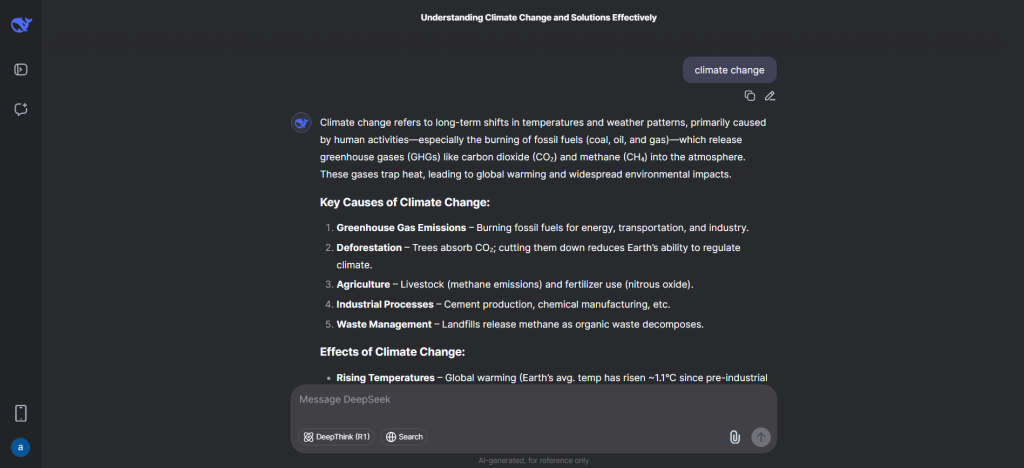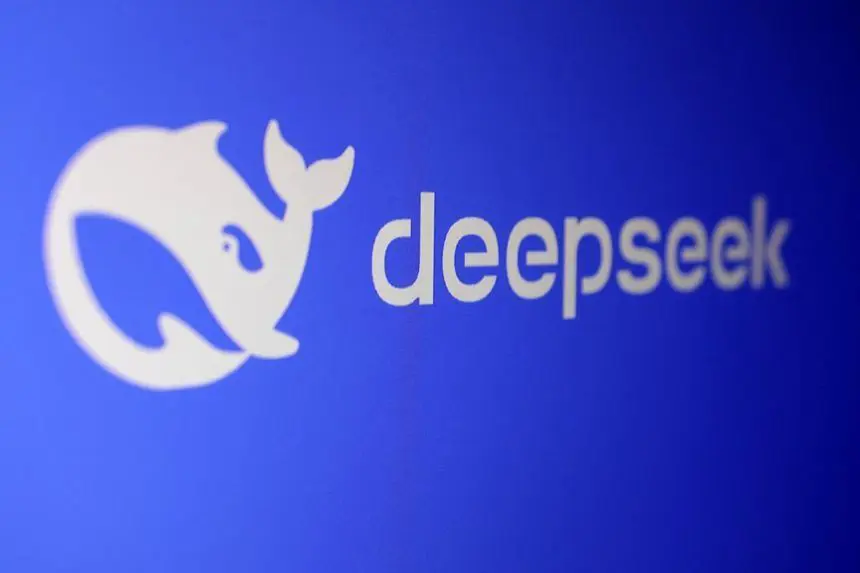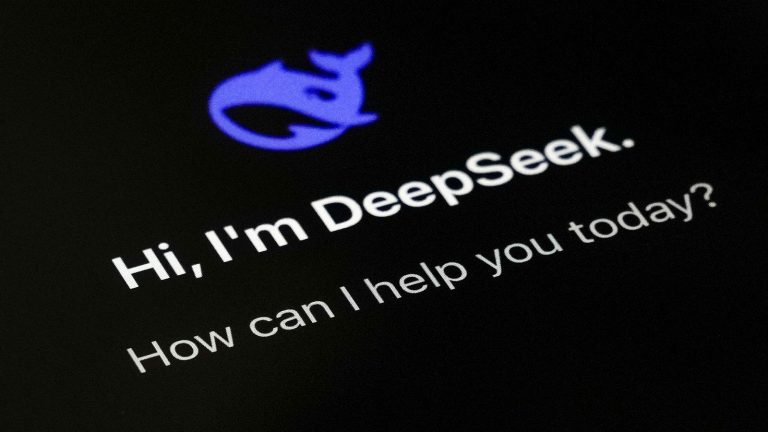DeepSeek: An AI Study Assistant for Students
DeepSeek is a state-of-the-art AI assistant platform built on large language models (LLMs) that has rapidly become popular among students and educators worldwide. Unlike many proprietary AI tools, DeepSeek’s models are open source and cost-efficient, which means students can access powerful AI help without expensive fees. In fact, when DeepSeek released its advanced R1 model in early 2025, the free DeepSeek chatbot app quickly shot to the top of the app store, even outranking OpenAI’s ChatGPT in downloads.
This meteoric rise in usage reflects how DeepSeek for students has emerged as a game-changer in education. With a friendly chat interface and strong reasoning abilities, DeepSeek acts as an AI study assistant capable of answering questions, tutoring on difficult subjects, and aiding in a variety of academic tasks. The following sections explore how students can leverage DeepSeek to enhance their learning – from grasping complex concepts to solving problems and improving their writing – all while using AI responsibly in education.
DeepSeek for Students: Simplifying Complex Science and History
One of the biggest benefits of DeepSeek for students is how it can break down complex concepts in subjects like science and history. Difficult textbook topics or dense lectures can be made clearer with DeepSeek’s explanations. The AI is adept at explaining technical concepts in simpler terms, much like a patient tutor.
In fact, some universities explicitly recommend using AI tools to simplify tough concepts – for example, Flinders University suggests using LLMs to explain complex ideas in plain language for better student understanding. DeepSeek exemplifies this capability: it can walk a student through a physics theory or a historical event step-by-step, providing context and analogies that make the material more approachable. According to documented use cases, DeepSeek’s “Homework Assistance” feature can solve math problems or explain physics concepts step-by-step when asked. Similarly, it can act as a virtual history coach – students can ask “Why did X historical event happen?” and get a structured, contextual answer.

For instance, a high schooler might ask DeepSeek to clarify the causes of World War I or to outline the process of photosynthesis; DeepSeek would respond with an easy-to-follow explanation, highlighting key factors or steps. By delivering information in a conversational, digestible format, DeepSeek helps learners grasp challenging scientific theories and historical narratives that might otherwise be overwhelming. This personalized, on-demand explanation not only saves study time but also deepens comprehension by allowing students to ask follow-up questions until they truly understand the topic.
Solving Math Problems with DeepSeek
Mathematics is another area where DeepSeek shines as a study companion. Many students struggle with complex math problems in homework or exam prep, and an AI tutor like DeepSeek can provide step-by-step guidance. DeepSeek is capable of working through problems in algebra, geometry, calculus and more, explaining each step of the solution in detail. In fact, DeepSeek’s reasoning abilities in math are so advanced that its R1 model rivals top-tier models from OpenAI in mathematical problem-solving. Students can input a tricky equation or word problem and ask DeepSeek for help – the AI might begin by explaining the approach (for example, identifying which formula or theorem applies), then demonstrate how to carry out each calculation. Documented use cases confirm that “Math Problem Solving” with DeepSeek extends to tackling advanced algebra and calculus problems with thorough explanations.
For example, imagine a university student is stuck on an integral calculus question. They can prompt DeepSeek with the problem, and the AI might respond with a breakdown of how to solve the integral – first explaining which integration technique to use, then solving it stepwise, and finally simplifying the result while pointing out each rule used. This is immensely helpful for learning, because the student isn’t just getting the answer; they’re seeing why and how to get the answer. DeepSeek essentially acts as a virtual math tutor, highlighting errors and offering hints. A high school student could even use DeepSeek to double-check their algebra homework – for instance, by asking it to solve an equation and comparing the steps to their own work. Additionally, DeepSeek can generate extra practice problems or sample quiz questions on demand (its use cases include an exam prep mode for creating practice questions), giving students more material to hone their skills. By providing guided solutions and instant feedback, DeepSeek helps demystify math and builds students’ problem-solving confidence outside of class.
DeepSeek for Essay Writing and Academic Research
Writing assignments and research projects are integral to student life, and DeepSeek serves as a versatile AI writing assistant in these areas. When it comes to writing essays, DeepSeek can support students at every stage of the process. For example, if a student is having trouble brainstorming ideas or outlining an essay, they can ask DeepSeek for help. The AI might suggest a possible structure for an essay on, say, climate change – including an introduction that frames the issue, key points for each body paragraph (e.g. scientific evidence, economic impacts, policy solutions), and a concluding insight.

By providing an outline or talking through ideas, DeepSeek helps students overcome writer’s block with a solid starting point. From there, students can draft their essay and later employ DeepSeek as a proofreader and editor. The model can review written paragraphs for clarity and correctness – one of DeepSeek’s documented abilities is content editing, where it will polish drafts by checking grammar and style and even suggest clearer ways to phrase sentences.
For instance, a student could paste a rough draft of their history essay into DeepSeek and ask for improvement suggestions. DeepSeek might catch grammatical errors, point out awkward phrasing, and recommend more formal vocabulary or transitions to improve the flow. The student remains in control of which changes to accept, but this AI-driven feedback is like having a personal writing coach available 24/7. It not only catches mistakes but can explain grammar rules or reasoning behind a suggestion if asked, thereby teaching the student how to improve their writing skills in the long run.
Beyond essays, DeepSeek is also a powerful ally for academic research tasks. Research often involves digesting complex scholarly articles, gathering relevant information, and synthesizing insights – all tasks that AI can expedite. DeepSeek can act as a tireless research assistant by quickly scanning and summarizing dense material.
In practice, students have used it to generate concise summaries of journal papers or book chapters, helping them identify the main arguments and evidence without spending hours reading every word. In fact, one of DeepSeek’s noted use cases is “Research Summaries,” where it condenses academic papers into digestible overviews. This means a biology student struggling to understand a 10-page research paper on genetics could ask DeepSeek for a summary, and receive a clear explanation of the study’s purpose, methods, and findings in plain language. Similarly, DeepSeek can assist with literature reviews: it can compare and synthesize findings from multiple sources, helping thesis writers see the big picture across various publications.
For example, a graduate student could input several abstracts or findings on a topic and have DeepSeek highlight common themes or disagreements among the authors. This accelerates the process of pinpointing gaps in the research or forming a thesis argument. DeepSeek can even help generate citations or recommend additional sources (if connected to a knowledge base or with proper prompting), though students should always verify and use proper citation styles themselves.
Finally, DeepSeek’s ability to provide feedback on drafts (through its editing and “peer review support” features) means that for academic papers or reports, it can suggest improvements in argumentation or structure as well. In short, whether it’s an essay for English class or a full research project, DeepSeek helps students write more effectively by acting as an intelligent sounding board, editor, and summarizer all in one. It’s important to note that the content it generates should be used as support and inspiration – the student’s own critical thinking and voice must remain central to the work – but as a tool, DeepSeek significantly lightens the load of writing and research.
DeepSeek for Language Learning: Practice, Grammar, and Translation
For students and learners tackling new languages, DeepSeek functions as a highly adaptable language tutor. Languages require practice in reading, writing, and even thinking in new ways – and DeepSeek’s AI capabilities are well-suited to support these needs.
Grammar practice and correction is one area where DeepSeek excels. A learner can write a sentence or paragraph in the language they’re learning (for example, French or Japanese) and ask DeepSeek to check it; the AI will review the text for grammatical accuracy, proper syntax, and clarity, much like a teacher marking an exercise. According to one detailed review, DeepSeek offers language learners “precise explanations and writing assistance” – it can clarify grammar rules, suggest more natural phrasing, and correct mistakes to help you sound more like a native speaker.
If you’re unsure about when to use the subjunctive in Spanish or the correct word order in German, you can simply ask DeepSeek for an explanation or examples, and it will break down the rule in simple terms. This on-the-spot feedback helps learners quickly understand and fix their errors.
Beyond written grammar, DeepSeek also aids in vocabulary building and translation. You can treat DeepSeek as a smart dictionary or translator: ask for the meaning of a word or a direct translation of a phrase, and it will provide accurate answers in your target language. In fact, DeepSeek’s multilingual training allows it to convert text between languages (for instance, English and Chinese) seamlessly.
But it goes further than a typical translation app by also offering context – if you ask DeepSeek to translate a sentence, it can additionally explain the subtle nuances or suggest alternate word choices for different contexts. Furthermore, DeepSeek can generate vocabulary lists on a given topic (travel, food, business, etc.) along with usage examples, effectively acting as a personalized vocabulary coach.
Perhaps the most impressive feature for language learners is DeepSeek’s ability to simulate conversations and provide interactive practice. While it’s not a voice-speaking app, DeepSeek can carry out a text-based dialogue in the language you’re learning.
For example, a student practicing French can instruct DeepSeek, “Let’s have a conversation. I’ll be a customer in a café and you be the waiter.” The AI will then respond in French as a waiter might, allowing the student to practice writing their replies. This kind of simulated dialogue is extremely useful for developing fluency and thinking in the language.
According to users, DeepSeek can adopt the role of a native speaker in chat, which helps learners practice forming sentences and even get corrections in real time. If the student makes a mistake or writes something unnatural, they can ask DeepSeek to correct them, turning the exercise into an immediate learning opportunity. This approach is akin to having a patient conversation partner who is available anytime.
To illustrate, imagine a learner is trying to improve their English as a second language. They might write a short essay or email and have DeepSeek proofread it for them; the AI would not only point out grammatical errors but also explain why something is incorrect or suggest a more idiomatic way to express a thought. Or consider a student learning Japanese who is confused about when to use casual vs. polite speech: they could ask DeepSeek to explain this cultural nuance, and the AI would deliver a clear answer with examples of each style. In reviews, DeepSeek is praised as “a powerful AI tool for language learners, offering personalized exercises and the ability to clarify grammar, expand vocabulary, and simulate conversations”, making it a valuable supplement to traditional learning methods.
While DeepSeek doesn’t replace speaking practice with real people (and the lack of voice interaction means learners should still practice pronunciation elsewhere), it fills a crucial gap by providing instant, tailored feedback in writing and comprehension. By using DeepSeek to check their work, practice dialogues, and explore translations, language learners can accelerate their progress and gain confidence in using the new language.
Responsible Use of AI in Education: Final Thoughts
As powerful as DeepSeek is, it’s important for students to use this AI assistant responsibly and ethically in their learning journey. Like any tool, how you use it determines whether it genuinely helps you learn or simply does the work for you (which would undermine the learning process). Educators and experts emphasize that AI should be treated as a supportive tool – akin to a calculator or an encyclopedia – rather than a shortcut to avoid learning. In other words, students should use DeepSeek to assist with sub-tasks and understanding, but still do the critical thinking and final work themselves.
One academic analogy puts it well: we should teach students to use LLMs “like they would a calculator – get the LLM to do a basic sub-task and then use their own creativity and intellect to refine the output into a well-considered result”. For example, it’s fine to have DeepSeek explain a tough concept or proofread a draft, but copying an entire essay generated by AI would be a misuse that leaves the student learning little.
Schools and universities are already developing guidelines for AI usage. A common recommendation is transparency: if you do use AI to help with an assignment, acknowledge and cite its assistance per your institution’s policy. Using AI might be permitted for generating ideas or checking grammar, but not for writing the whole assignment for you.
Open Universities Australia, for instance, advises students to use tools like DeepSeek or ChatGPT for brainstorming and proofreading while explicitly crediting the AI’s contribution, and strongly warns against letting the AI produce the entire submission. Such guidelines ensure that the student remains the true author of their work and maintains academic integrity.
Similarly, when DeepSeek provides information or answers (especially for research questions), it’s the student’s responsibility to fact-check those answers against reliable sources. AI models, while advanced, can occasionally produce incorrect or fabricated information, so a savvy student will verify important facts rather than accept everything blindly.
Another aspect of responsible use is developing one’s own skills with the AI’s help rather than becoming dependent on it. For instance, if DeepSeek helps solve a math problem, a student should still practice doing similar problems on their own to ensure they’ve learned the method. If DeepSeek suggests improvements to an essay, the student can take those suggestions as learning points to improve their next piece of writing.
In essence, the goal is to use DeepSeek to enhance learning – not replace it. When used in this spirit, AI study assistants can greatly benefit education. They free up time on routine tasks (like grammar checking or summarizing content), allowing students to focus more on understanding and creativity. They also provide personalized help at any hour, which is especially valuable for learners who might not have access to tutors or who study at odd times.
Many educators are coming around to the view that, much like calculators and the internet, AI can be a positive force in education if integrated thoughtfully. By adhering to ethical guidelines and using DeepSeek as a complementary aid, students can boost their learning outcomes and develop important skills in critical thinking and AI literacy.
In conclusion, DeepSeek offers tremendous advantages as an AI study assistant – helping to clarify, solve, write, and translate – but the true power of this tool is realized when students engage with it responsibly, keeping their own learning and growth at the center of the educational experience.


